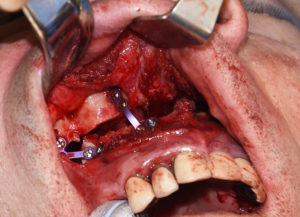Orthognathic surgery is a well known type of bone procedures that move the upper and lower jaws to improve one’s bite (occlusion) as well as improve jaw relationships to the face. It is done on the upper and lower jaws with the mainstay procedures of a LeFort I osteotomy (upper jaw) and sagittal split ramus osteotomies. (lower jaw)
The LeFort I osteotomy moves the upper jaw and is done by a horizontal bone cut above the level of the upper tooth roots across the maxilla and nose. This allows the entire dentoalveolar unit of the maxilla to be moved horizontally forward or vertically up or down. When seen intraoperatively it is a dramatic procedure when one sees the whole upper jaw brought down to peer into the maxillary sinuses and the nose.

The indications for a premaxillary osteotomy are very limited. The picture in this blog is from an older patient who wanted his front upper teeth moved up and back to correct a lifelong tongue thrusting problem. This was able to be done for him because he was already missing his first premolar tooth on the right side and had a decayed second premolar tooth on the opposite side which could be removed. This provide a safe space to make the vertical bone cuts.


